
Catocala is a generally Holarctic genus of moths in the family Erebidae. The genus was erected by Carl Linnaeus in his 1767 12th edition of Systema Naturae. The moths are commonly known as underwing moths or simply underwings. These terms are sometimes used for a few related moths, but usually – especially when used in plural, not as part of a species name – they are used to refer to Catocala only.

Catocala electa, the rosy underwing, is a moth of the family Erebidae. The species was first described by Karl Friedrich Vieweg in 1790. It can be found in Europe and Asia.
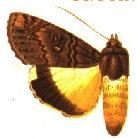
Ulotrichopus is a genus of moths in the family Erebidae. The genus was described by Wallengren in 1860.
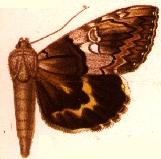
Catocala deuteronympha is a moth of the family Erebidae. It is found from eastern Siberia to Japan and Korea.
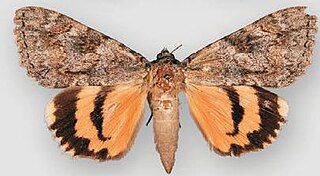
Catocala jessica, the Jessica underwing, is a moth of the family Erebidae. The species was first described by Henry Edwards in 1877. It was described in the United States from Arizona through Colorado to Illinois and California.

Catocala sordida, the sordid underwing, is a moth of the family Erebidae. The species was first described by Augustus Radcliffe Grote in 1877. It is found in North America from Saskatchewan east to New Brunswick and Prince Edward Island and south through Maine and Connecticut to Florida, west to Texas and north to Manitoba.
Catocala ulalume, the Ulalume underwing, is a moth of the family Erebidae. The species was first described by Herman Strecker in 1878. It is found in the United States from Virginia through Georgia to Florida, west to Texas and Oklahoma and north to Illinois.
Catocala bella is a moth of the family Erebidae first described by Arthur Gardiner Butler in 1877. It is found in Russia, Korea, China and Japan.

Euparthenos is a monotypic moth genus in the family Erebidae erected by Augustus Radcliffe Grote in 1876. Its only species, Euparthenos nubilis, the locust underwing, was first described by Jacob Hübner in 1823. The adults resemble some of the underwing moths of genus Catocala, which are fairly close relatives, in color, pattern, and the habit of resting on tree trunks. But E. nubilis can usually be immediately recognized by the four concentric black bands per hindwing, as opposed to one or two in Catocala. Color morphs of E. nubilis with altered pattern are known, however, and these may be hard to recognize without detailed examination.
James Halliday McDunnough was a Canadian linguist, musician, and entomologist best known for his work with North American Lepidoptera, but who also made important contributions about North American Ephemeroptera.
Catocala distorta is a moth in the family Erebidae. It was described by Arthur Gardiner Butler in 1889. It is found in Himachal Pradesh, India. The species is 52 millimetres (2.0 in) long and is different from Catocala nymphaea by being more brown and having much duller thorax and forewing.
Catocala inconstans is a moth in the family Erebidae first described by Arthur Gardiner Butler in 1889. It is found in Himachal Pradesh, India.
Catocala jonasii is a moth in the family Erebidae first described by Arthur Gardiner Butler in 1877. It is found in Japan.
Catocala mirifica is a moth in the family Erebidae first described by Arthur Gardiner Butler in 1877. It is found in Japan.
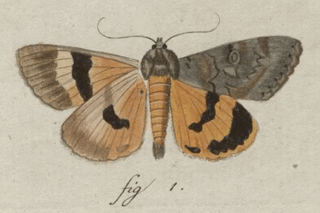
Catocala neonympha is a moth in the family Erebidae first described by Arthur Gardiner Butler in 1877. It is found in south-western Russia, Ukraine, Kazakhstan, eastern Turkey, Iraq, Armenia, Kurdistan, Afghanistan, the Altai Mountains and southern Siberia.

Catocala nivea is a moth in the family Erebidae first described by Arthur Gardiner Butler in 1877. It is found in Japan and Taiwan.
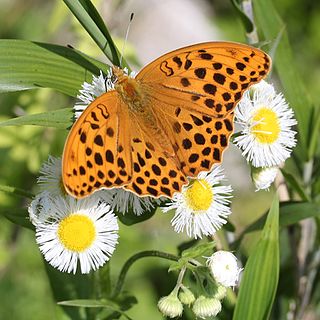
Argynnis anadyomene is a butterfly found in the East Palearctic that belongs to the browns family.
William David Barnes was an American entomologist and surgeon. He was the son of Dr. William A. and Eleanor Sawyer Barnes. He graduated salutatorian from the Decatur High School in 1877. Then spent a year at Illinois State University followed by a year at University of Illinois at Urbana–Champaign. In 1879, he entered Harvard Medical School and graduated in 1886. While at Harvard, he met naturalist Louis Agassiz and his love of Lepidoptera grew. Agassiz taught him how to preserve and classify the butterflies. He completed an internship at Boston City Hospital and then studied abroad in Heidelberg, Munich, and Vienna. In 1890, Dr. Barnes came home to Decatur and opened his medical practice. That same year he married Charlotte L. Gillette. The couple had two children: William Barnes Jr., and Joan Dean Gillett Barnes.







